Plantation-Scale Oil Production
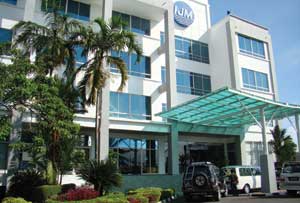
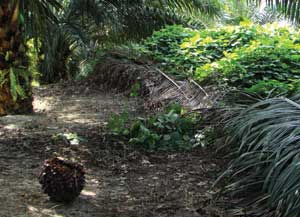
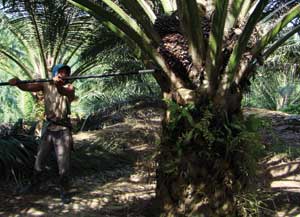
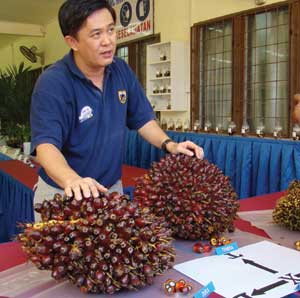
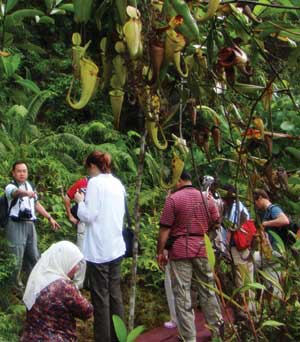

August 8, 2008
BY Susanne Retka Schill / Story & Photos
World palm oil production has been nudging soybean oil production out of the No. 1 spot in recent years with nearly 90 percent of production coming from just two countries-Malaysia and Indonesia. Sheer distance keeps familiarity with the competition difficult for the American soybean industry. In April, Biodiesel Magazine got a closer look at the Malaysian palm oil industry while attending the first International Palm Oil Sustainability Conference. The trip to Malaysia included a tour of IJM Plantations Bhd. in the Malaysian state of Sabah on the northern coast of Borneo.
The tour began at the corporate headquarters in Sandakan, a city known for its ecotourism. IJM is Malaysia's second-largest construction firm with international operations in Dubai, United Arab Emirates and India. The company entered the palm oil business two decades ago, and has built its planted area up to 80,000 acres this year with plans to expand into Indonesia and India. "We are expanding in areas of degraded forest," explains IJM's Chief Executive Officer Velayuthan Tan, who has experience dealing with environmental activists critical of oil palm production. "I'm a lover of nature, but we came here for economics," Tan says. "Yet it's not just about profits." In addition to the open management style of its plantation operations, the publicly traded company has developed its own research and training center, and is a member of the Roundtable for Sustainable Palm Oil. IJM has initiated several programs to preserve native trees and plants as a heritage for the future, Tan says.
The road from corporate headquarters to the company's research center passes through a rolling countryside covered with oil palm plantings. In the past few years, the road has been paved, vastly improving transportation conditions during the rainy season. According to one of the guides, the taxes paid by the state's plantations-which amount to 45 percent of their earnings-have provided for infrastructure improvements in roads, electricity and schools in the state. The gravel road leading into IJM's research center winds through hills planted to oil palm with plenty of culverts and water diversions, potholes and washouts demonstrating the power of the rains-the region receives 120 inches of rain annually. The chief executive officer's love of nature shows in the landscaping at the research center. The flower beds serve a double purpose, beautifying the landscape and providing an alternate host for beneficial insects.
At the research center, IJM is striving to improve the yields from its oil palm production as they replace trees with new hybrids. Breeding efforts focus on decreasing the proportion of the hull in the fruit and increasing the outer layer which produces oils high in C16 and C14 fatty acids. The kernel is generally crushed separately to extract the oil, which is high in C12 lauric acid.
Production Basics
While an oil palm tree will grow for 100 years, its practical life in a plantation is about 25 years. Beyond that it is too tall to harvest. The traditional practice of burning the old growth before replanting is now banned in Malaysia. Today, the land is mechanically cleared before the young trees are transplanted. Oil palm trees grow 1.5 feet per year and start flowering and setting fruit roughly three years after planting. The trees are most productive at seven to 12 years of age. The average oil yield in Malaysia is 19 metric tons per hectare (7.7 tons per acre) although top producers get 25 tons per hectare (10 tons per acre).
Surprisingly the crop that produces nearly 40 million tons of oil annually worldwide is hand harvested. Harvesters check trees three times a month, watching for one to three ripe fruits to drop to the ground, which indicates that the bunch is ready to be harvested. The harvester cuts away the frond that covers the stalk with a sharp knife mounted on a long pole. Then he chops the thick stalk, releasing the fruit bunch to fall to the ground. One tree will produce between 12 to 20 fruit bunches annually, with each bunch weighing between 44 and 66 pounds, depending on the age of the tree and available nutrients. In the peak season a good harvester can cut 300 to 400 bunches a day that are piled alongside the roads that crisscross the plantation. Other workers throw the bunches onto trucks that carry the fruit to the plantation's mill for processing. Because oil palm fruit is perishable it requires prompt processing to kill the enzymes that begin to degrade the crop's quality in the heat and humidity of the tropical climate.
Like American farmers, oil palm growers follow best management practices. Integrated pest management methods include using pheromone traps and encouraging beneficial insects. IJM's policy is to use insecticides as a last resort. Rodent damage to fruit bunches is controlled by encouraging owls to populate the plantation. At IJM, mill waste is composted and applied to the ground as a natural fertilizer, along with leguminous ground covers that fix nitrogen and control soil erosion. In addition, commercial fertilizers are broadcast four times a year.
"Palm oil production is labor intensive," says Joseph Tek, IJM's general manager of plantations, making workforce management a major part of his job. The company has 4,700 employees, from corporate management to migrant workers. The rule of thumb is that one worker is needed for every 10 hectares (22 acres) if the land is relatively flat; and one worker per 6 hectares (13 acres) if the terrain is more difficult.
The tour then moved from IJM's research and training center, to the company's largest plantation district along the Sabang River. The Sugut region is considered "new frontier," and is an hour's boat ride from the research center along the northeastern coast of Borneo. Its remoteness required the company to build its own roads, generate its own power and provide housing for the 2,500 employees in the district. IJM goes a step further and also provides recreational facilities and opportunities. As part of its corporate social responsibility efforts, IJM opened its first school last year and subsidizes the education for workers' children.
Preserving Plant Heritage
IJM has other ideas for the Sugut district beyond oil palm cultivation and processing. The company is hoping to showcase the rich biological diversity native to the rainforest. "We're looking for someone to manage an agri-ecotourism business here," Tek says. The company built four guest houses last year and a clubhouse building with a kitchen, dining space and two meeting rooms. The clubhouse is in the company's arboretum-an area with a diverse sampling of the native tree species that weren't touched when the area was logged decades ago. Within a short walking distance is a medicinal plant collection, displaying many of the flowers and shrubs native to the district's rainforests. A total of 200 acres has been set-aside to connect the arboretum to protected mangrove forests that grow along the river.
IJM continues to discover and protect natural resources. This spring, workers built a wooden boardwalk along a service road in the middle of the palm trees where numerous specimens of the carnivorous pitcher plant were found. A few weeks earlier, Tek says they spotted orangutan nests in the treetops in a deep, steep valley that had been passed over by loggers decades ago when the rainforest conversion first occurred. "I'm proposing the company set that aside for conservation," he says. Besides the orangutan, plantation workers spot proboscis monkeys along the river near the company's landing and oil storage tanks and hornbills in the arboretum. "The plantation is trying to live in harmony with the animals and nature," Tek says.
Susanne Retka Schill is a Biodiesel Magazine staff writer. Reach her at sretkaschill@bbiinternational.com or (701) 738-4922.
The tour began at the corporate headquarters in Sandakan, a city known for its ecotourism. IJM is Malaysia's second-largest construction firm with international operations in Dubai, United Arab Emirates and India. The company entered the palm oil business two decades ago, and has built its planted area up to 80,000 acres this year with plans to expand into Indonesia and India. "We are expanding in areas of degraded forest," explains IJM's Chief Executive Officer Velayuthan Tan, who has experience dealing with environmental activists critical of oil palm production. "I'm a lover of nature, but we came here for economics," Tan says. "Yet it's not just about profits." In addition to the open management style of its plantation operations, the publicly traded company has developed its own research and training center, and is a member of the Roundtable for Sustainable Palm Oil. IJM has initiated several programs to preserve native trees and plants as a heritage for the future, Tan says.
The road from corporate headquarters to the company's research center passes through a rolling countryside covered with oil palm plantings. In the past few years, the road has been paved, vastly improving transportation conditions during the rainy season. According to one of the guides, the taxes paid by the state's plantations-which amount to 45 percent of their earnings-have provided for infrastructure improvements in roads, electricity and schools in the state. The gravel road leading into IJM's research center winds through hills planted to oil palm with plenty of culverts and water diversions, potholes and washouts demonstrating the power of the rains-the region receives 120 inches of rain annually. The chief executive officer's love of nature shows in the landscaping at the research center. The flower beds serve a double purpose, beautifying the landscape and providing an alternate host for beneficial insects.
At the research center, IJM is striving to improve the yields from its oil palm production as they replace trees with new hybrids. Breeding efforts focus on decreasing the proportion of the hull in the fruit and increasing the outer layer which produces oils high in C16 and C14 fatty acids. The kernel is generally crushed separately to extract the oil, which is high in C12 lauric acid.
Production Basics
While an oil palm tree will grow for 100 years, its practical life in a plantation is about 25 years. Beyond that it is too tall to harvest. The traditional practice of burning the old growth before replanting is now banned in Malaysia. Today, the land is mechanically cleared before the young trees are transplanted. Oil palm trees grow 1.5 feet per year and start flowering and setting fruit roughly three years after planting. The trees are most productive at seven to 12 years of age. The average oil yield in Malaysia is 19 metric tons per hectare (7.7 tons per acre) although top producers get 25 tons per hectare (10 tons per acre).
Surprisingly the crop that produces nearly 40 million tons of oil annually worldwide is hand harvested. Harvesters check trees three times a month, watching for one to three ripe fruits to drop to the ground, which indicates that the bunch is ready to be harvested. The harvester cuts away the frond that covers the stalk with a sharp knife mounted on a long pole. Then he chops the thick stalk, releasing the fruit bunch to fall to the ground. One tree will produce between 12 to 20 fruit bunches annually, with each bunch weighing between 44 and 66 pounds, depending on the age of the tree and available nutrients. In the peak season a good harvester can cut 300 to 400 bunches a day that are piled alongside the roads that crisscross the plantation. Other workers throw the bunches onto trucks that carry the fruit to the plantation's mill for processing. Because oil palm fruit is perishable it requires prompt processing to kill the enzymes that begin to degrade the crop's quality in the heat and humidity of the tropical climate.
Like American farmers, oil palm growers follow best management practices. Integrated pest management methods include using pheromone traps and encouraging beneficial insects. IJM's policy is to use insecticides as a last resort. Rodent damage to fruit bunches is controlled by encouraging owls to populate the plantation. At IJM, mill waste is composted and applied to the ground as a natural fertilizer, along with leguminous ground covers that fix nitrogen and control soil erosion. In addition, commercial fertilizers are broadcast four times a year.
"Palm oil production is labor intensive," says Joseph Tek, IJM's general manager of plantations, making workforce management a major part of his job. The company has 4,700 employees, from corporate management to migrant workers. The rule of thumb is that one worker is needed for every 10 hectares (22 acres) if the land is relatively flat; and one worker per 6 hectares (13 acres) if the terrain is more difficult.
The tour then moved from IJM's research and training center, to the company's largest plantation district along the Sabang River. The Sugut region is considered "new frontier," and is an hour's boat ride from the research center along the northeastern coast of Borneo. Its remoteness required the company to build its own roads, generate its own power and provide housing for the 2,500 employees in the district. IJM goes a step further and also provides recreational facilities and opportunities. As part of its corporate social responsibility efforts, IJM opened its first school last year and subsidizes the education for workers' children.
Preserving Plant Heritage
IJM has other ideas for the Sugut district beyond oil palm cultivation and processing. The company is hoping to showcase the rich biological diversity native to the rainforest. "We're looking for someone to manage an agri-ecotourism business here," Tek says. The company built four guest houses last year and a clubhouse building with a kitchen, dining space and two meeting rooms. The clubhouse is in the company's arboretum-an area with a diverse sampling of the native tree species that weren't touched when the area was logged decades ago. Within a short walking distance is a medicinal plant collection, displaying many of the flowers and shrubs native to the district's rainforests. A total of 200 acres has been set-aside to connect the arboretum to protected mangrove forests that grow along the river.
IJM continues to discover and protect natural resources. This spring, workers built a wooden boardwalk along a service road in the middle of the palm trees where numerous specimens of the carnivorous pitcher plant were found. A few weeks earlier, Tek says they spotted orangutan nests in the treetops in a deep, steep valley that had been passed over by loggers decades ago when the rainforest conversion first occurred. "I'm proposing the company set that aside for conservation," he says. Besides the orangutan, plantation workers spot proboscis monkeys along the river near the company's landing and oil storage tanks and hornbills in the arboretum. "The plantation is trying to live in harmony with the animals and nature," Tek says.
Susanne Retka Schill is a Biodiesel Magazine staff writer. Reach her at sretkaschill@bbiinternational.com or (701) 738-4922.
Advertisement
Advertisement
Advertisement
Advertisement
Upcoming Events





